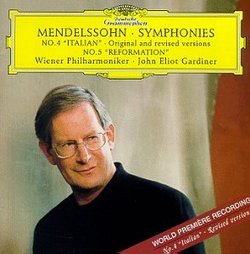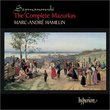| All Artists: Felix Mendelssohn, John Eliot Gardiner, Wiener Philharmoniker Title: Mendelssohn: Symphonies Nos. 4 "Italian" & 5 "Reformation" Members Wishing: 0 Total Copies: 0 Label: Deutsche Grammophon Release Date: 3/9/1999 Genre: Classical Style: Symphonies Number of Discs: 1 SwapaCD Credits: 1 UPC: 028945915623 |
Search - Felix Mendelssohn, John Eliot Gardiner, Wiener Philharmoniker :: Mendelssohn: Symphonies Nos. 4 "Italian" & 5 "Reformation"
 | Felix Mendelssohn, John Eliot Gardiner, Wiener Philharmoniker Mendelssohn: Symphonies Nos. 4 "Italian" & 5 "Reformation" Genre: Classical
Audio CD; Deutsch Grammophon catalog #289 459 156-2; 1998; total playing time is 79:49. Mendelssohn's symphony No. 4 ("Italian" symphony) in both original and revised versions, and symphony No. 5 ("Reformation" symphony). ... more » |
Larger Image |
CD DetailsSynopsis
Product Description Audio CD; Deutsch Grammophon catalog #289 459 156-2; 1998; total playing time is 79:49. Mendelssohn's symphony No. 4 ("Italian" symphony) in both original and revised versions, and symphony No. 5 ("Reformation" symphony). Performed by the Wiener Philharmoniker, John Eliot Gardiner conducting. Similar CDs
Similarly Requested CDs
|
CD ReviewsPopular classics Brett A. Kniess | Madison, WI | 01/06/2006 (5 out of 5 stars) "Felix Mendelssohn was a Romantic composer who embraced the ideals of classicism when that trend in the Germanic countries were falling out of favor, save a few. The two symphonies represented on this disk show both the Romantic and Classicist: Symphony No. 4 "Italian" and Symphony No. 5 "Reformation". The famous Symphony No. 4 is inspired after a trip to Italy, and so subtitled the Italian symphony. Like in his third symphony, the Scottish, Mendelssohn stays away from any direct quotes of folk music, but uses the ideas, modes, and dance rhythms of the culture in his symphony. The sunny first movement has the famous leaping melody, which literally drips with joy. The clarinets and bassoon have a secondary melody of simplicity, but still with optimism. The development, with whimsical strings, leads to a darker march, but all gloom is pushed aside for a happy conclusion. The mood quickly changes in the second movement with unison woodwinds and strings, and a mournful bassoon/oboe duet. The unswerving walking bass throughout gives the movement perpetual motion and an almost martial quality. Some serenity shines through when the flute ensemble sings, but the gloom prevails. The third movement is more a courtly dance in the style of Mozart. Woodwinds dot the string-based movement, and besides a bassoon/horn call, gentility presides. The whirlwind fourth movement is in the form of an Italian dance known as the Saltarello. The movement is almost menacing, with constantly repeated unison notes and an uneven switch between duples and triples. Gardiner chooses forward-moving tempos throughout, but especially in the Saltarello, where the Vienna Philharmonic show their virtuosity. He gives the triplets a fleet-footed quality, whereas the duples get extra weight, adding to the menacing sound. In addition, throughout the work, great work and detail has been put into the inner parts, which now receive as much attention by the listener, as the melody. Gardiner's love of the work is evident, and his swifter approach works well, without losing musicality. Many of the movements are based in dance forms, and the Vienna Philharmonic, whose history is steeped in dance forms, makes the music sparkle, not dwelling in unneeded heaviness or stuffiness. A fresh perspective of a popular work. Mendelssohn's Symphony No. 5 (chronologically his 2nd) was written for the 300th anniversary of the Augsburg Confession, hence the subtitle Reformation symphony. A bit more serious sounding than the Fourth Symphony, it opens with a grand processional, and eventually into a faster section whose theme is a perfect fifth, much like a trumpet call. The action is interrupted occasionally, by a Dresden Amen cadence, a reminder of the religious subject. The second movement is a bit more upbeat, with an almost waltz-like feel. The third movement, primarily strings, seems to be a short prelude to the final movement, especially since there is no break. The finale is heralded on flute alone on the famous chorale, Ein feste Burg (A Mighty Fortress). An ingenious natural crescendo (by adding instruments) is very effective as it dramatically builds into an emotional cadence into the final fast section. The British march section (or so it sounds) has a stately melody mingled with quotations of the chorale, and a forceful conclusion. John Eliot Gardiner is faithful to the score, relishing in Mendelssohn's own dynamic and articulation markings, and bringing out the natural melodic materials. Again, great attention to detail, capturing a totally different mood than the previous symphony, with great success. In addition, 20+ minutes of Mendelssohn's revisions of the Italian Symphony has been restored and performed. Probably only interesting to die-hard Mendelssohn fans, a unique addition to the disk. As mentioned, a fresh look at Mendelssohn's music, bringing out detail and the composer's innate classicism, with Vienna's lightness and fruity sound. An easy choice for anyone who wants these symphonies." It is interesting to compare J. Buxton | Waltham, MA United States | 07/23/2001 (4 out of 5 stars) "There seems to be general agreement that Mendelssohn's revised version recorded here is inferior to the original version premiered (although here it is given a wonderful performance), and I agree with this assessment. Gardiner does a fine job bringing out the clarity and details in the textures, particularly of the Italian, and the Reformation stirs up quite a bit of excitement. The Vienna Philharmonic sound almost like a chamber ensemble at times, which brings lots of incisiveness and vitality to the scores. My one problem with this recording is the opening phrases of the Allegro vivace of the Italian symphony (familiar version). In my view it lacks a little weight in the strings, especially when compared to Sinopoli's version with the Philharmonia on DG or Blomstedt with the San Francisco Symphony on Decca (sadly not currently available in the US). I admit this is a small personal preference, and overall these recordings can be confidently recommended particularly with the bonus of the revised Italian symphony." Polished document of an inveterate musical self-critic klavierspiel | TX, USA | 08/10/2006 (5 out of 5 stars) "The ease and elegance of his music makes it tempting to believe that for Felix Mendelssohn, one of the great musical prodigies of history, the creative process was spontaneous and effortless. This CD of both the original and the recently unearthed revision of one of his most beloved works, the "Italian" Symphony No. 4, gives the lie to this myth. After successfully premiering the work in London in 1833, Mendelssohn, dissatisfied with the score, almost immediately began revising the last three movements--he desisted from tinkering with the first only because he was convinced a complete rewriting would be necessary, and hesitated to tackle such a Herculean task. In fact the changes in the movements that were revised are noticeable even to a listener not following a score.
It would be pleasant to report that the later revisions make a lovely work even more satisfying. In truth, they leave a mixed impression. In the 1834 version Mendelssohn retouches many details of the orchestration, giving more prominence overall to the winds. He simplifies the solemn theme of the second movement, but undercuts the apparent aim of increased austerity with the richer and more colorful scoring. The third movement receives the most extensive changes. With the arguable exception of a new and interesting transition back to the main section from the central trio, none of the alterations in the melodic line is any more beautiful than the flowing, graceful original. The central trio discards the dotted rhythms of the earlier version in favor of smooth interjections from the violins, pointing up the relationship to the main section but losing the airiness and grace that most listeners find to be one of Mendelssohn's most appealing traits. In comparison the insertion of an additional section, repeating an earlier theme, in the Presto finale seems a relatively minor alteration. Even Fanny Hensel, Mendelssohn's sister and an accomplished composer in her own right, occasionally lamented her brother's inability to leave a good thing well enough alone. Schumann in his later years revised many of his most famous early piano works. Posterity has judged his alterations to be inferior to the freshness and fantasy of the originals. One has the feeling that the revised "Italian" Symphony may suffer the same fate. Moreover, to perform the unrevised first movement with the later versions of the other three, as is happening nowadays, is utterly contrary to Mendelssohn's intent and no doubt would horrify him. Leaving such questions of musical ethics aside, it is difficult to fault the performances on this disc. Only in some slightly scrappy string passages in the first movement of the "Italian" do the Vienna Philharmonic and Gardiner sound a bit ill at ease. Otherwise orchestra and conductor capture the polished grace of both versions of the Symphony to perfection, and also make a strong case for the Symphony No. 5, the "Reformation," (actually written earlier than No. 4 and similarly unpublished during the composer's lifetime) bringing out its drama and varied moods, and minimizing its tendencies toward sanctimony. This CD is an essential addition to anyone's symphonic library." |

 Track Listings (11) - Disc #1
Track Listings (11) - Disc #1












